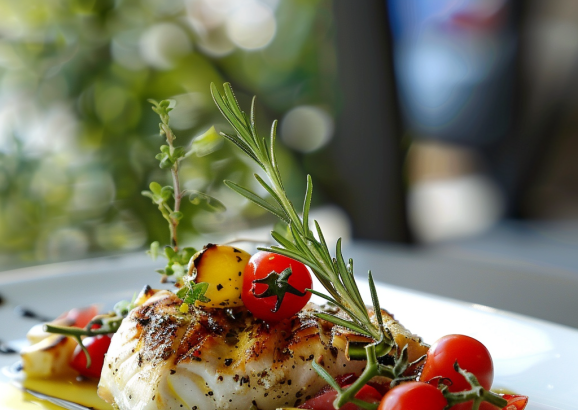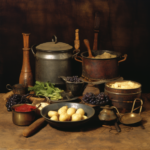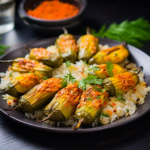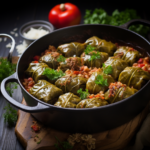Discover the magic of Greek Plating Principles to transform your meals from simple to stunning. How a meal can touch all your senses, starting with how it looks. Plating has become key in today’s cooking world. It turns eating into a feeling-rich experience that captivates all senses. A well-plated Greek dish delights the taste buds and catches the eye. It builds excitement and happiness before you even taste it.
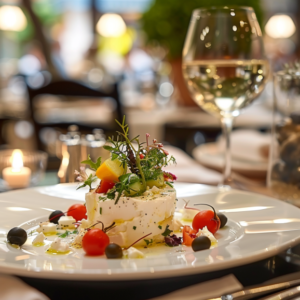
Elegant Greek food presentation
Key Takeaways
- Greek cuisine presentation enhances the overall dining experience.
- Elegant Mediterranean meals are visually captivating and flavor-rich.
- Greek plating aesthetics engage all the senses, creating anticipation.
- Visual impact in plating can evoke emotions and positive dining memories.
- The art of Greek plating reflects a rich culinary heritage.
The Art of Greek Cuisine Presentation
Greek cuisine is like a beautiful painting made of colors, textures, and flavors. Learning about Greek food styling is crucial. It helps respect the tradition and makes the food exciting for everyone.
The Importance of Visual Appeal
Greek food is known for its bright colors and layering of tastes. Using the right kitchen tools helps make the food look amazing. By mixing flavors and textures and using fresh, seasonal stuff, Greek dishes become works of art.
Greek Culinary Culture and Presentation
Greek food is all about looking good. Techniques like stacking and layering make the dishes interesting. Using sauces and things like olive oil adds beauty. Adding garnishes like edible flowers also makes the food more appealing.
Artistic plating changes a simple dish into something special. It’s about balancing, using colors well, and adding textures. The choice of plate matters too, affecting how the food looks.
Greek food presentation combines style with taste. Swirling sauces and adding decorations make the food beautiful and show care. By using these ideas, chefs can make every dish a delight for the senses.
Key Elements of Mediterranean Food Styling
Mediterranean food styling is both eye-catching and vibrant. It mirrors the vivid colors and textures of fresh ingredients. By showcasing the natural shapes in foods, it brings out their beauty. This turns every meal into a visual and tasty delight.
Bold Colors and Fresh Ingredients
Mediterranean styling uses bright colors and fresh items. This style, especially in Greek food, features tomatoes, eggplants, peppers, and zucchini. Their bright greens, deep reds, and rich purples are not just beautiful. They also show the dish is healthy. The focus on fresh items stems from Greek farming traditions.
Emphasizing Natural Geometry and Textures
Plating’s natural shapes are key in making dishes beautiful. Greek foods use the textures of beans, fish, meat, and dairy. This mix matches the look perfectly. Today, Greek farmers grow many crops. This keeps these textures important in Mediterranean styling.
Dishes are made attractive by balancing shapes and colors. The right choice of colors makes ingredients stand out. It adds depth and makes the meal look like gourmet food. Ancient Greek grilling methods are still used, highlighting texture’s role. Chefs use stacking and layering to make meals visually interesting. This shows off the ingredients’ natural shapes.
| Ingredient | Significance | Role in Food Styling |
|---|---|---|
| Olives | Staple ingredient, source of olive oil | Adds texture and robust flavor |
| Tomatoes | Cultivated by modern farmers | Brings vibrant color and juiciness |
| Eggplants | Popular staple in Greek dishes | Offers rich color and meaty texture |
| Peppers | Enhanced agricultural yields | Brightens the presentation with bold colors |
New plating styles and the shapes and sizes of tableware make dishes stand out. They attract people who want a special dining experience. This approach blends the beauty of natural items, their shapes, and textures. It captures the spirit of Mediterranean food styling.
Mastering Olive Oil Drizzling Techniques
Olive oil is a key ingredient in Greek food, enhancing both flavor and appearance. The right drizzle adds a beautiful sheen, standing out against other elements on the plate.
Olive oil drizzling shows a chef’s skill and elevates a dish’s quality. Here are essential tips to remember:
- Balance: It’s vital to make sure olive oil doesn’t overpower other ingredients. It should complement them nicely.
- Color: A golden drizzle brings out the vibrant colors of vegetables, meats, and grains. It makes the dish look more inviting.
- Textures: A mix of crunchy and creamy textures with olive oil makes the dish more interesting.
- Negative Space: Skillful drizzling creates visual appeal, focusing attention on the main ingredients.
Mastering olive oil drizzling is key in Greek culinary art. It turns a simple dish into something extraordinary. This technique enhances both the taste and the look, making a meal truly memorable.
By using these drizzling methods, your Greek dishes will not only taste great but look amazing too. It’s not just about the ingredients but how you present them. This makes your food come alive.
The Role of Feta Cheese in Greek Plating Principles
Feta cheese is a key player in Greek meals. It adds both taste and beauty to dishes, showing the spirit of Greek cooking. Its role has been important since ancient times. This shows how crucial this cheese is even today.
Selection and Preparation of Feta Cheese
When picking feta cheese, know its textures and how it ages. Aged feta is great for salads because it crumbles well. A softer feta is good for slicing into stylish wedges. The trick is choosing the right feta to match your dish. This makes it essential for Greek food presentation.
Creative Garnishing Ideas
Using feta cheese in creative ways can make your dishes look and taste better. Here are some ideas:
- Crumbled Feta: Perfect for topping salads, veggies, or meats for extra flavor and texture.
- Sliced Wedges: Use feta wedges to enhance cheese boards or with olives and tomatoes.
- Whipped Feta: Mix feta with olive oil and herbs for a creamy spread.
- Stuffed Feta: Fill peppers or tomatoes with feta for a flavor-packed treat.
Garnishing with feta cheese follows Greek food rules. It also lets diners enjoy Greek cuisine’s balance and harmony.
| Feta Cheese Preparation | Recommended Uses |
|---|---|
| Crumbled | Salads, Roasted Vegetables, Grilled Meats |
| Sliced Wedges | Cheese Boards, Platter Accompaniments |
| Whipped | Spreads, Layered Dishes |
| Stuffed | Peppers, Cherry Tomatoes |
Knowing how to choose, prepare, and decorate with feta cheese can make your Greek meals unforgettable. It will improve both the look and taste of your dishes.
Pita Bread Plating: Enhancing the Experience
Pita bread plating turns a meal into a special event. It can either support the main dish or be the highlight. By mixing old and new plating ideas, you can make eating truly engaging.
Traditional and Modern Styles
In Greece, pita often comes with dips like hummus or holds meats such as souvlaki. This method celebrates Greek food traditions and feels comforting. Yet, modern dishes bring creativity to pita plating through shapes and layers. Combining the gold of baked pita with colorful veggies makes the dish pop.
Incorporating Pita in Various Dishes
Pita bread fits perfectly into both traditional and contemporary Greek meals. It can wrap grilled meats or serve as a salad base. Good plating, which includes balancing and color matching, makes pita dishes both tasty and eye-catching.
Perfecting Tzatziki Sauce Presentation
The way you present Tzatziki sauce is very important in Greek food. Its creamy texture and cool taste make it the star of Mediterranean dishes.
Consistency and Texture
For great Tzatziki sauce, it must be thick and smooth. This gives a rich look and shows it’s fresh and well-made. The creamy texture is a sign of top-quality Greek cooking.
Visual Appeal and Accompaniments
To make Tzatziki sauce look even better, think about how you garnish it. A bit of olive oil adds a shiny gold look. This contrasts well with the white of the sauce.
Adding fresh herbs like dill or mint gives a fresh green highlight. It shows the beauty of Greek cuisine. A little paprika can also make the sauce look more inviting with its red color.
Serving Tzatziki with fresh veggies like tomatoes, cucumbers, and olives makes it more appealing. These add-ons follow Greek cooking traditions that focus on fresh and local food.
“The intricate art of Tzatziki sauce presentation is a testament to the broader emphasis on aesthetics in Greek cuisine, merging the visual allure with the flavors of the Mediterranean.” — Renowned Greek Chef
By paying attention to these tips, your Tzatziki sauce won’t just taste good. It will also be a beautiful part of the meal, showcasing Greek cooking at its best.
Greek Plating Principles for Balanced Meals
In Greek cooking, making balanced meals with thoughtful plating is key. To make balanced Greek meals, you need to know about proportions and harmony. This ensures everything on the plate works well together, making eating a great experience.
Proportions and Harmony
Creating balanced Greek meals is about putting the right food groups together. A usual way to divide a plate looks like this:
- Half of the plate: Filled with colorful vegetables and fruits.
- A quarter of the panel: For whole grains.
- A quarter of the platform: With healthy proteins.
This approach does more than provide a nutritious meal. It also makes the dish look good. Having each part in its place invites us to enjoy the dish with all our senses.
Combining Different Elements Effectively
It’s important to mix different things on the plate well for balanced Greek meals. Keep these ideas in mind:
- Colors and Textures: Use warm and cool colors like greens and golds. It makes the dish interesting to look at.
- Flavor Harmony: Mix heavy and light foods, like proteins with salads. It makes the whole meal feel right.
- Use of Negative Space: Place things in a way that makes the main parts stand out. This draws our attention to them.
Picking the right plates is also important. Choosing ones that reflect Mediterranean beauty can make the meal look better.
| Component | Proportion | Example |
|---|---|---|
| Vegetables and Fruits | ½ of the plate | Fresh Greek Salad |
| Whole Grains | ¼ of the plate | Whole Grain Pita |
| Healthy Proteins | ¼ of the plate | Grilled Chicken or Fish |
By focusing on balance in plating, Greek meals can be both nutritious and beautiful. Paying attention to proportions and presentation turns every meal into a special experience. This shows the beauty and taste of Greek cooking traditions.
Creative Greek Salad Arrangement Techniques
Making a Greek salad an enjoyable and beautiful dish involves some creative steps. Here’s the way to make a perfect Greek salad that pleases the taste buds and catches the eye with Mediterranean flair.
First, it’s key to use the bright colors of Greek ingredients, like sweet tomatoes, crisp cucumbers, tangy olives, and creamy feta cheese. These items not only taste great but also make the dish visually appealing.
“Artistic plating elevates dishes to extraordinary by enhancing the visual appeal and creating elegant culinary creations.”
Choosing the right plates is important. White plates, often preferred by chefs, make the salad’s colors stand out. Also, playing with different plate shapes and sizes adds creativity to your salad presentation.
Balance is crucial in mixing colors, textures, and flavors. Ensure that no single ingredient dominates, for a perfect blend on the plate. This approach captures the true spirit of Greek culinary tradition.
Adding height with stacking and layering makes the salad more interesting and look fuller. This method also offers various views of the beautiful ingredients.
The dishes you use should match or contrast with your salad for visual impact. Understanding the color wheel can help you make your ingredients pop. This technique enhances the salad’s visual appeal.
Using edible flowers and herbs adds beauty and a fresh touch. These not only add lively colors but elevate the look. A thoughtful drizzle of dressing adds the final touch to your Greek salad arrangement.
| Key Technique | Impact on Presentation |
|---|---|
| Using White Plates | Highlights vibrant colors of ingredients |
| Stacking and Layering | Creates visual interest and height |
| Incorporating Edible Flowers | Adds fresh and natural color elements |
| Strategic Garnishing | Provides a harmonious and appealing look |
In the end, being creative with your Greek salad shows the beauty of Greek simplicity and taste. By focusing on how each element is placed, you turn a simple dish into a stunning centerpiece that’s as wonderful to eat as it is to look at.
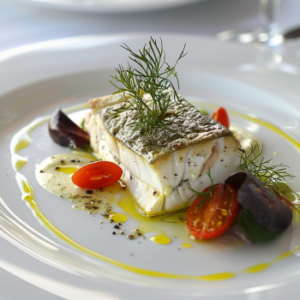
Grilled Meat and Seafood Platters: Techniques and Tips
Grilled meat and seafood are key to Greek cooking, blending great taste with beauty. To make a great platter, choose the right meat and quality seafood. Moreton Bay Bugs are a good pick for their taste and value. They taste a lot like lobster. Buy your seafood from fishmongers or markets for the best quality. They care more for their seafood than big stores do.
For perfect grilled dishes, aim for nice grill marks and roasted veggies. Roast potatoes, onions, cauliflower, and carrots to bring out colors and flavors. On white plates, food colors and textures pop. Bright veggies make the plate look more inviting too.
A balanced platter needs carefully arranged elements. Use dishes of the right size to make each part stand out. Playing with heights makes the plate look fuller. A beautiful plate can make food seem tastier. Studies say people will pay more for it. Keep to six items max on a plate. This keeps it from getting too crowded and makes the meal better-looking and tastier.
Ultimate Guide to Greek Food Presentation
Ultimate Guide to Greek Food Presentation
Mastering the Art of Greek Food Presentation: A Comprehensive Guide
Discover the essentials of Greek food presentation with our comprehensive guide. Learn Greek plating principles for elegant meals, and enhance your dishes with these top presentation tips. Explore various methods of presenting Greek cuisine, understand the aspects of Greek food presentation, and master the elements of Greek food presentation.
FAQ
What is the significance of Greek cuisine presentation?
Presenting Greek cuisine is vital. It makes the dining experience better, touches all senses, and shows Greek food culture. Good presentation makes dishes look appealing and prepares you for a tasty meal.
How does visual appeal affect the dining experience?
Good-looking food makes us feel and think about taste. It sets the mood and starts the excitement. Beautiful Greek dishes bring back memories and get us excited before we even taste them.
What elements are crucial in Mediterranean food styling?
Important parts of Mediterranean food styling are bold colors and fresh stuff. Also, showing off the natural shapes and textures of things like olives and leafy greens is key.
How do you master olive oil drizzling techniques?
To get better at drizzling olive oil, practice making a light, steady stream. Aim to make the dish look dynamic. This trick adds flavor and makes food look inviting by reflecting light.
What role does feta cheese play in Greek plating?
Feta cheese brings taste and looks to Greek food. How you pick and prepare it changes how it impacts a dish. This allows for different styles and creative garnishes.
How can pita bread enhance the overall culinary experience?
Whether served traditionally or in a new way, pita bread improves meals by adding texture and taste. It’s great for dipping or making wraps, well-matching the main dish.
What is important in presenting tzatziki sauce?
Presenting tzatziki sauce well means it should look creamy and inviting. Adding herbs, olive oil, or paprika as garnishes improves its looks and the dish’s beauty.
How do you achieve balanced meals with Greek plating principles?
Balanced Greek dishes combine different parts in harmony. Every item adds to the meal. Mixing textures, colors, and tastes well makes a meal complete and enjoyable.
What techniques can transform a Greek salad into an artistic dish?
Making a Greek salad artistic involves layering veggies, placing olives and feta carefully, and dressing it lightly. These steps show off the freshness and make it look great.
What are some tips for presenting grilled meat and seafood platters?
For grilled meats and seafood, pick high-quality pieces, aim for perfect grill lines, and place seafood with care. Add beautiful garnishes and sides for a visually appealing and tasty dish.






